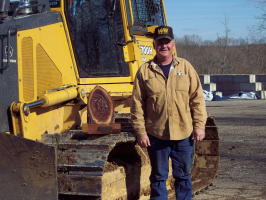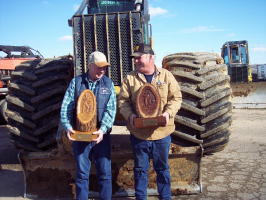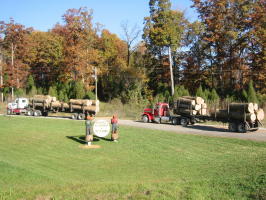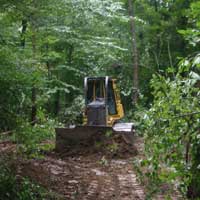ETIENNE'S LOGGING
Indiana's 2005 Logger of the Year
Phil Etienne's Logging was named Indiana's 2005 Logger of the Year. We were proud to receive this award at the IHLA convention in Indianapolis on February 1st. We began logging in 1973, but turned our focus to sawmilling in 1983 until January of 2002 when we returned to logging. From 1983 until 2002 our logs were supplied by two contract logging companies. One of which was Richard Greg Etienne Logging (Phil's brother). Greg's crew received the award in 1988. Due to health reasons Greg retired in 2002. Phil is pictured below standing in front of his 700H John Deere Dozer with his award. The picture on the right is Phil with Greg in front of Greg's 640G John Deere Skidder.
What to expect from a harvest
Woodlots are managed for timber, wildlife, water quality, recreation, retirement funds, college funds, and a host of specific goals. Each landowner chooses the time to harvest and the specific approach to benefit their long term goals. Professional assistance is readily available to help make decisions. After harvest selection is made and agreements on price reached it is time to harvest. Before the crew arrives a harvest plan is developed with the landowner or their representative.
Our timber cutters are trained in directional felling and take great pride in protecting future crop trees.
During our logging operation we keep impact as minimal as possible as some pretty important folks will be watching.
After a tree is cut and topped the skidder drags it into the yard. The operator repositions and changes angles of the drag to keep from wounding non-harvest crop trees.
In the yard an automatic slasher saw manufactures the trees into logs from 7 to 16 feet lengths. The operator cuts for grade utilization as well as product utilization. He is always communicating with the lumber inspectors at the sawmill to guarantee maximum log utilization. Maximum yield at the saw insures top dollar being paid to the landowner for his timber.
He also loads the trucks for transportation to the sawmill. At the mill the logs are sorted and sawn by specie and grade. Some supply green lumber for furniture, cabinets, flooring, doors, trim, and other structural products. Some will be used for wood carvings. Some will be used to make material for pallets.
While this process of harvest and manufacturing has been going on, the final step of site closure is proceeding in the woodlot. The timber cutters and skidder operators took care of the remaining crop trees during harvest and now that the logging disturbance is finished, the soil must be stabilized. There has been an on going process of smoothing skid trails in finished areas and installing erosion preventing water bars in areas where the harvest was completed, but now it is time to close out the job. Water bars are dirt diversions on steep inclines channeling water out of the trails and on to the leaf litter of the forest floor to prevent erosion and protect water quality.
As the last trees are processed and transported to the sawmill, the skidders remove tops from fields or major streams. If any fences were cut to allow trees to fall into fields they are repaired. Any items discarded during logging are removed from the site.
As the slasher saw is pulled out and heads for the next job along with the skidders and cutters the bulldozer moves into the log yard and hauling area. Sometimes yards are seeded and strawed. Sometimes a little rock is used to top dress a road. Each site is different and may vary a little at closure.
Some of our landowners have our construction operators actually construct a permanent road rather than the temporary roads usually used. This is only an option chosen if permanent access fits into the landowners long range plans.
Managed woodlots are healthier and more vigorous than non-harvest woodlots. In a world of limited resources, wood is the best environmental choice. We don't have to wait for a dinosaur to die to create fuel. We don't have to experience a huge catastrophic event to move tons of rock to create coal or ore. We just have to harvest wisely. Isn't wood GREAT?
Buyers of Standing Timber
Supporters of the Sustainable Forestry Initiative Program (SFI)
Buyers - Licensed and Bonded
Operators Professionally Trained
BMP (Best Management Practices) Applied to ALL harvests.
Buyers - Phil Etienne & Robin Etienne
For more information email us at pethinc@psci.netor call our office at 812-843-5208.







